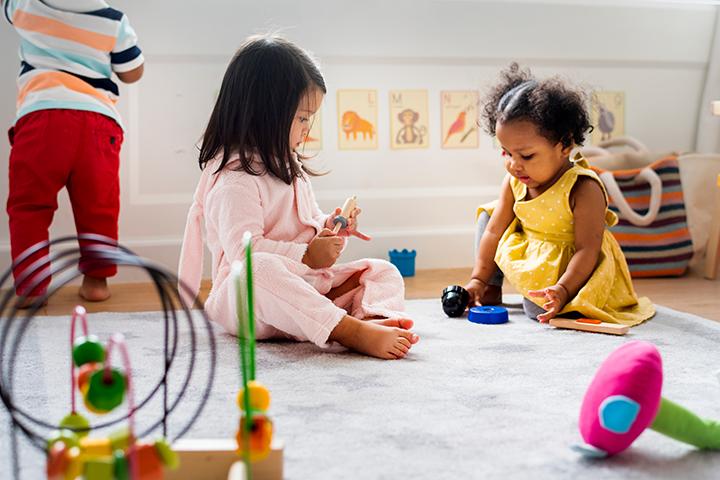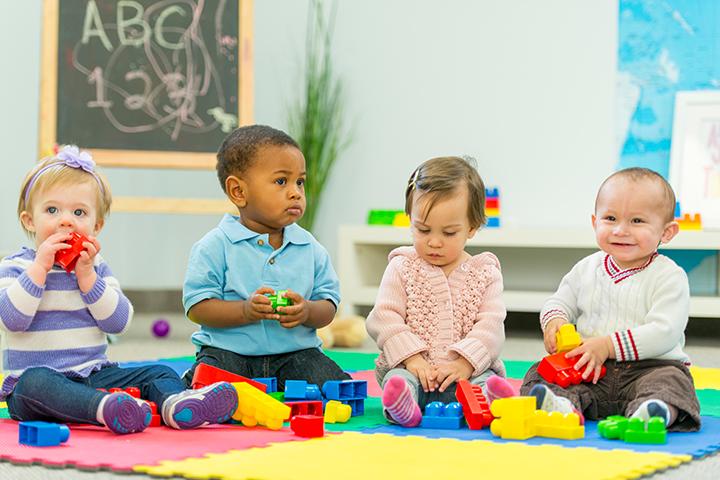Toddlers begin participating in activities with other children their age between the ages of three and four. They will be more concerned with the other children or the object involved in the game than with the activity itself. Associative play is the name for this type of game. Also, you’ll observe that there isn’t any interaction between the toddlers in these group activities, nor is there any organization to obtain a shared goal (1) (2). It’s a wonderful sight to witness your toddlers interact with one another. This early period of social engagement also aids your toddler in reaching critical developmental milestones. In this post, we discuss what associative play is and how it benefits toddlers while also explaining, in brief, the six stages of play during childhood.
Stages Of Play
Mildred Bernice Parten Newhall, a researcher at the University of Minnesota’s Institute of Child Development, developed the theory of six stages of play that children experience. Associative play falls into the fifth category. Let’s learn about each of these stages (2) (3).
- Unoccupied play (0–3 months old): The baby only observes and does not play in this stage. They may make some movements and learn how their body moves.
- Solitary play (0–2 years old): The baby starts playing alone and concentrating on activities, such as playing with building blocks.
- Onlooker play (2 years old): The baby begins to gain interest in others playing around but only watches them and does not interact with them.
- Parallel play (2–3 years old): The child starts playing near others, but not with them. They may play alone and, sometimes, imitate the actions of other children around them.
- Associative play (3–4 years old): The child begins to develop an interest in people around them. The child may do the same activity as other children, but there will be very little interaction and no organization.
- Cooperative play (4+ years old): The child is involved in communication and takes an active part in the activity at hand. There is cooperative play, organization, and teamwork.
Examples Of Associative Play
The following are some examples of activities that children usually indulge in during associative play.
- Building a tower of blocks without planning and competition
- Sharing the same playground and using the same play equipment, such as slides, swings, merry-go-rounds, and climbers
- Cycling next to other children without choosing a destination
- Playing dress-up for a Halloween party or pirate-themed party
- Sharing a play kitchen and using play utensils, toys, etc.
- Painting or doing other craft art using the same material, but not commenting on each other’s work or completing the art together
- Playing with the same toy without chatting with each other
- Doing activities such as puzzles or connect-the-dots in preschool
- Dancing at a party without any competition with each other
- Eating their meals together during recess
- Forming a line to go to the washroom
- Running around in a circle without a motive to catch each other
- Playing on the playground without communication, however taking turns
You can get kids working together with the Ball Canvas Challenge. They laugh and have fun as they roll a colorful box, talking to decide which way it goes. This activity is all about playing and working as a team, and it’s so much fun that everyone wants to join in, even those who don’t usually play together. Dana M. Gorman, a teacher, organized this activity for her students. While talking about the steps, Gorman says, “We used an over sized pizza box taped open and reinforced. We cut paper from a large roll to fit inside the box. We precut several sheets of paper as we knew it would be a popular activity. Three small trays were filled with tempera paint in primary colors and thinned with water to allow the balls to roll rather than stick to the paper. We chose to use ping pong balls, but small wiffle balls, golf balls or other balls you have on hand would work. It would be fun to elaborate on this idea trying different balls and comparing the marks made (i).”
Benefits Of Associative Play
Your child is no longer in their own world in the associative play stage. Their world is expanding as they start including people other than their caregivers into their lives. Associative play can help children develop valuable skills and learn important values. Here are some benefits of associative play (4) (5) (6) (7) (8) (9) (10).
- Cooperation and sharing: Although your child may not be involved in putting in joint efforts needed to achieve a common goal at this stage, associative play can be amusing and encourages them to share common resources, such as a swing or slide, and prepares them to take part in group activities.
- Respect and turn-taking: It can help them understand the importance of turn-taking and make them aware that there are certain rules for every activity and that these activities benefit the whole group. Also, as they play in a group setting, it could help them learn to respect each other.
- Problem-solving: The child starts exercising the skills they have learned during the onlooker play and parallel play stages. As they become more active during the associative play stage, they learn to find solutions to their problems by doing things themselves, observing other children, or interacting with other children to a certain extent.
- Language development: It is a captivating stage where children start to interact with others in a social setting. Children would try to verbalize their feelings, which can help develop their vocabulary and enable them to form simple sentences.
- Preparedness for school: The communication and friendship skills acquired at this stage can help your child get comfortable in school. Associative play, which involves collaborative and entertaining activities, allows children to mingle with peers of the same age group. Through play, they learn valuable skills such as sharing, to take turns, and cooperate which can ease their transition into school without much difficulty.
- Fitness: Participating in stimulating activities with other children can make them more active. Staying active and taking part in physical activities can help develop their motor skills and strengthen their bones and muscles.
- Brain development: Taking part in imaginative activities through associative play helps boost their thinking capacity, concentration, imagination, cognition, and creative skills. It is through play that children explore and make sense of the world around them. Taking part in activities can help stimulate their brain and engage their senses.
Ways To Encourage Associative Play
As your child steps into the world of associative play, their social awareness and interactions start to increase. You can encourage associative play by using these ideas (4):
- Provide materials: Give a variety of materials, such as Lego blocks or colorful clays, to your child and their friends so they can share.
- Comment on the events: Even if children are doing something different, comment about what another child is doing to increase your child’s interest in their activity. Commenting on the experiences also gives a sense of belonging and a boost to get along with others.
- Create drama: Make up a story for pretend play wherein every child has to work towards the same goal. This is a fun way to improve social skills.
The associative play marks the beginning of a child’s social skills when they observe how their peers play. However, there will be little or no interaction with other children in that phase. Cycling next to peers without knowing the destination, sharing the same play area, and sharing play equipment are examples of associative play. This indicates that your child is not in their world, and they begin to learn interactive and social skills. Associative play enhances language development, develops problem-solving abilities, and prepares a child to join the school. You may provide opportunities for your child to participate in engaging activities next to their peers to enhance these developmental milestones.
Allow your child to explore the world around them. Don’t be possessive if you don’t find yourself grabbing all the attention of your toddler during this transition stage, as you will always be their favorite person.
Key Pointers
- Before learning to play associatively, children go through several stages of playing.
- Indulging toddlers in associative play fosters a sense of sharing and cooperation.
- Cycling with friends, roleplay activities with peers, and eating meals together are a few examples of associative play.















